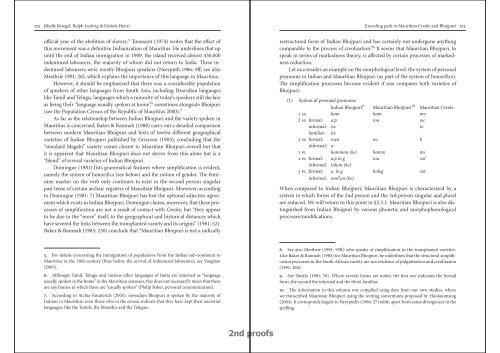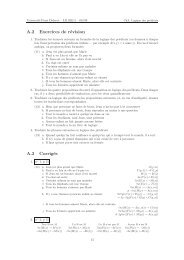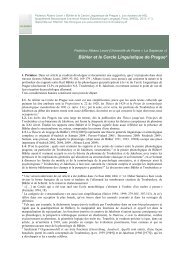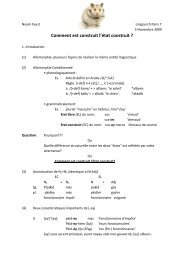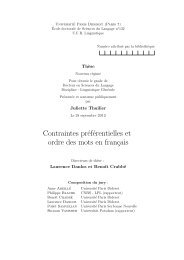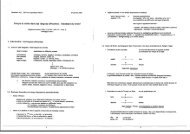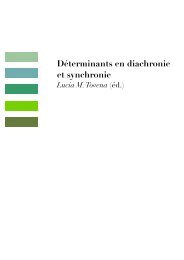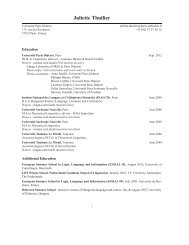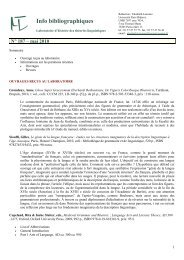Encoding path in Mauritian Creole and Bhojpuri - Laboratoire de ...
Encoding path in Mauritian Creole and Bhojpuri - Laboratoire de ...
Encoding path in Mauritian Creole and Bhojpuri - Laboratoire de ...
You also want an ePaper? Increase the reach of your titles
YUMPU automatically turns print PDFs into web optimized ePapers that Google loves.
Sibylle Kriegel, Ralph Ludwig & Fabiola Henri<strong>Encod<strong>in</strong>g</strong> <strong>path</strong> <strong>in</strong> <strong>Mauritian</strong> <strong>Creole</strong> <strong>and</strong> <strong>Bhojpuri</strong> official year of the abolition of slavery. 5 Toussa<strong>in</strong>t (1974) writes that the effect ofthis movement was a <strong>de</strong>f<strong>in</strong>itive Indianization of Mauritius. He un<strong>de</strong>rl<strong>in</strong>es that upuntil the end of Indian immigration <strong>in</strong> 1909, the isl<strong>and</strong> received almost 450,000<strong>in</strong><strong>de</strong>ntured labourers, the majority of whom did not return to India. These <strong>in</strong><strong>de</strong>nturedlabourers were mostly <strong>Bhojpuri</strong> speakers (Neerputh 1986: 9ff; see alsoMesthrie 1991: 26), which expla<strong>in</strong>s the importance of this language <strong>in</strong> Mauritius.However, it should be emphasized that there was a consi<strong>de</strong>rable populationof speakers of other languages from South Asia, <strong>in</strong>clud<strong>in</strong>g Dravidian languageslike Tamil <strong>and</strong> Telugu, languages which a m<strong>in</strong>ority of today’s speakers still <strong>de</strong>clareas be<strong>in</strong>g their “language usually spoken at home”, 6 sometimes alongsi<strong>de</strong> <strong>Bhojpuri</strong>(see the Population Census of the Republic of Mauritius 2000). 7As far as the relationship between Indian <strong>Bhojpuri</strong> <strong>and</strong> the variety spoken <strong>in</strong>Mauritius is concerned, Baker & Ramnah (1988) carry out a <strong>de</strong>tailed comparisonbetween mo<strong>de</strong>rn <strong>Mauritian</strong> <strong>Bhojpuri</strong> <strong>and</strong> texts of twelve different geographicalvarieties of Indian <strong>Bhojpuri</strong> published by Grierson (1903), conclud<strong>in</strong>g that the“st<strong>and</strong>ard Magahi” variety comes closest to <strong>Mauritian</strong> <strong>Bhojpuri</strong> overall but thatit is apparent that <strong>Mauritian</strong> <strong>Bhojpuri</strong> does not <strong>de</strong>rive from this alone but is a“blend” of several varieties of Indian <strong>Bhojpuri</strong>.Dom<strong>in</strong>gue (1981) lists grammatical features where simplification is evi<strong>de</strong>nt,namely the system of honorifics (see below) <strong>and</strong> the notion of gen<strong>de</strong>r. The fem<strong>in</strong><strong>in</strong>emarker on the verb only cont<strong>in</strong>ues to exist <strong>in</strong> the second person s<strong>in</strong>gularpast tense of certa<strong>in</strong> archaic registers of <strong>Mauritian</strong> <strong>Bhojpuri</strong>. Moreover, accord<strong>in</strong>gto Dom<strong>in</strong>gue (1981: 7) <strong>Mauritian</strong> <strong>Bhojpuri</strong> has lost the optional adjective agreementwhich exists <strong>in</strong> Indian <strong>Bhojpuri</strong>. Dom<strong>in</strong>gue claims, moreover, that these processesof simplification are not a result of contact with <strong>Creole</strong>, but “they appearto be due to the “move” itself, to the geographical <strong>and</strong> historical distances whichhave severed the l<strong>in</strong>ks between the transplanted variety <strong>and</strong> its orig<strong>in</strong>s” (1981: 52).Baker & Ramnah (1985: 230) conclu<strong>de</strong> that “<strong>Mauritian</strong> <strong>Bhojpuri</strong> is not a radicallyrestructured form of Indian <strong>Bhojpuri</strong> <strong>and</strong> has certa<strong>in</strong>ly not un<strong>de</strong>rgone anyth<strong>in</strong>gcomparable to the process of creolization.” 8 It seems that <strong>Mauritian</strong> <strong>Bhojpuri</strong>, tospeak <strong>in</strong> terms of markedness theory, is affected by certa<strong>in</strong> processes of markednessreduction.Let us consi<strong>de</strong>r an example on the morphological level: the system of personalpronouns <strong>in</strong> Indian <strong>and</strong> <strong>Mauritian</strong> <strong>Bhojpuri</strong> (as part of the system of honorifics).The simplification processes become evi<strong>de</strong>nt if one compares both varieties of<strong>Bhojpuri</strong>:(1) System of personal pronounsIndian <strong>Bhojpuri</strong> 9 <strong>Mauritian</strong> <strong>Bhojpuri</strong> 10 <strong>Mauritian</strong> <strong>Creole</strong>1 ham ham mo2 formal: a:p tou ou<strong>in</strong>formal: tu:tofamiliar: tæ3 formal: wan ou li<strong>in</strong>formal: u:1 hamman (ke) hamni nu2 formal: a:p lo:g tou zot<strong>in</strong>formal: tuhan (ke)3 formal: u: lo:g holog zot<strong>in</strong>formal: onn h an (ke)When compared to Indian <strong>Bhojpuri</strong>, <strong>Mauritian</strong> <strong>Bhojpuri</strong> is characterized by asystem <strong>in</strong> which forms of the 2nd person <strong>and</strong> the 3rd person s<strong>in</strong>gular <strong>and</strong> pluralare reduced. We will return to this po<strong>in</strong>t <strong>in</strong> §2.3.2. <strong>Mauritian</strong> <strong>Bhojpuri</strong> is also dist<strong>in</strong>guishedfrom Indian <strong>Bhojpuri</strong> by various phonetic <strong>and</strong> morphophonologicalprocesses/modifications. For <strong>de</strong>tails concern<strong>in</strong>g the immigration of populations from the Indian sub-cont<strong>in</strong>ent toMauritius <strong>in</strong> the 18th century (thus before the arrival of <strong>in</strong><strong>de</strong>ntured labourers), see Vaughan(2005). Although Tamil, Telugu <strong>and</strong> various other languages of India are returned as “languageusually spoken <strong>in</strong> the home” <strong>in</strong> the <strong>Mauritian</strong> censuses, this does not necessarily mean that thereare any homes <strong>in</strong> which these are “usually spoken” (Philip Baker, personal communication). Accord<strong>in</strong>g to Atchia-Emmerich (2005), nowadays <strong>Bhojpuri</strong> is spoken by the majority ofIndians <strong>in</strong> Mauritius, even those who <strong>in</strong> the census <strong>in</strong>dicate that they have kept their ancestrallanguages, like the Tamils, the Marathis <strong>and</strong> the Telugus. See also Mesthrie (1991: 93ff) who speaks of simplification <strong>in</strong> the transplanted varieties.Like Baker & Ramnah (1985) for <strong>Mauritian</strong> <strong>Bhojpuri</strong>, he un<strong>de</strong>rl<strong>in</strong>es that the structural simplificationprocesses <strong>in</strong> the South African variety are not evi<strong>de</strong>nce of pidg<strong>in</strong>ization <strong>and</strong> creolization(1991: 104). See Shukla (1981: 76). Where several forms are noted, the first one <strong>in</strong>dicates the formalform, the second the <strong>in</strong>formal <strong>and</strong> the third, familiar. The <strong>in</strong>formation <strong>in</strong> this column was compiled us<strong>in</strong>g data from our own studies, wherewe transcribed <strong>Mauritian</strong> <strong>Bhojpuri</strong> us<strong>in</strong>g the writ<strong>in</strong>g conventions proposed by Hookooms<strong>in</strong>g(2004). It corresponds largely to Neerputh’s (1986: 27) table, apart from some divergences <strong>in</strong> thespell<strong>in</strong>g.2nd proofs


